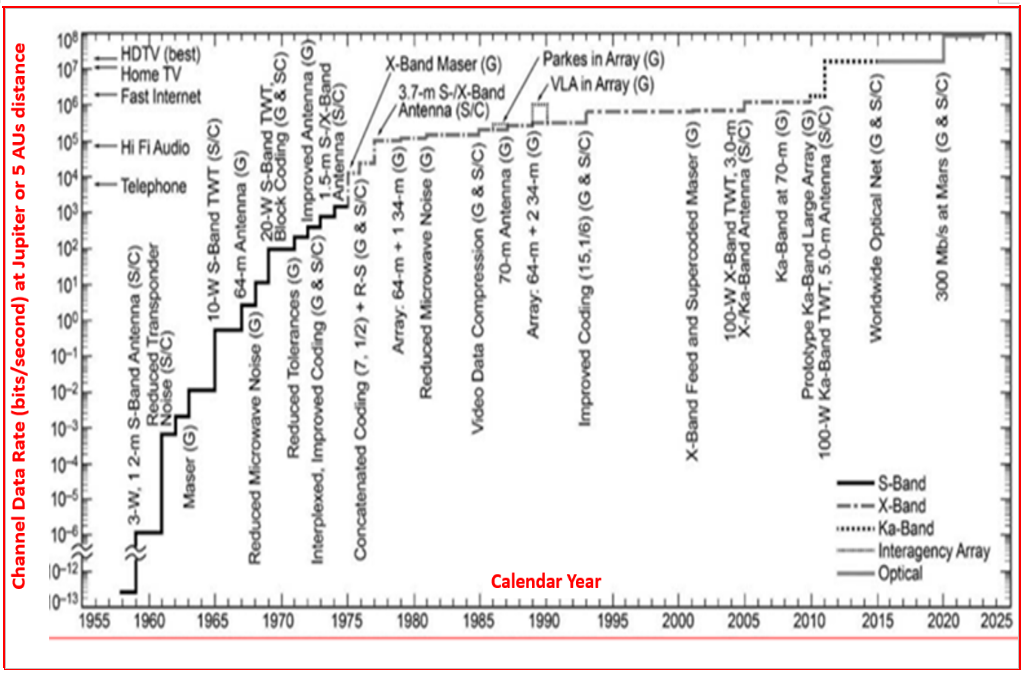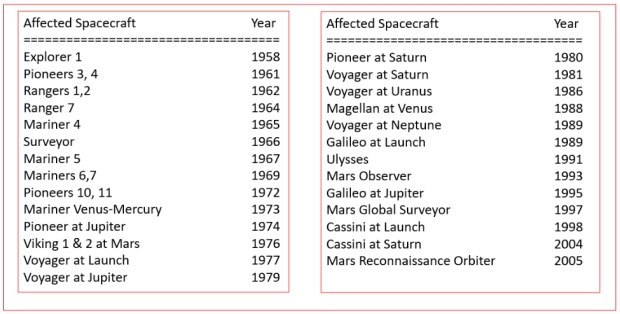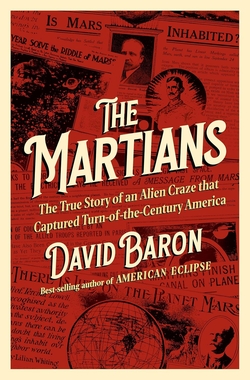Centauri Dreams
Imagining and Planning Interstellar Exploration
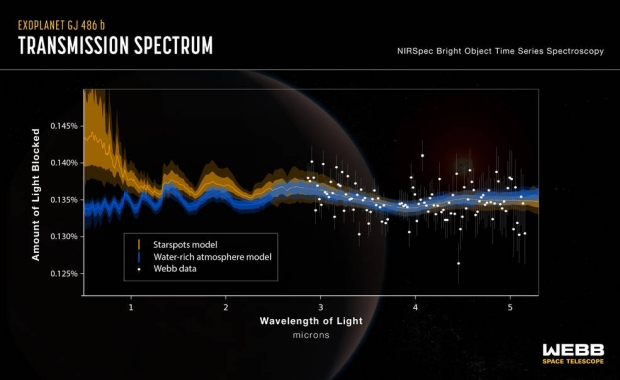
GJ 486b: An Atmosphere around a Rocky M-dwarf Planet?
I might have mentioned the issues involving the James Webb Space Telescope’s MIRI instrument in my earlier post on in-flight maintenance and repair. MIRI is the Mid-Infrared Instrument that last summer had issues with friction in one of the wheels that selects between short, medium and longer wavelengths. Now there seems to be a problem, however slight, that affects the amount of light registered by MIRI’s sensors.
The problems seem minor and are under investigation, which is a good thing because we need MIRI’s capabilities to study systems like GJ 486, where a transiting rocky exoplanet may or may not be showing traces of water in an atmosphere that may or may not be there. MIRI should help sort out the issue, which was raised through observations with another JWST instrument, the Near-Infrared Spectrograph (NIRSpec). The latter shows tantalizing evidence of water vapor, but the problem is untangling whether that signal is coming from the rocky planet or the star.
This points to an important question. GJ 486b is about 30 percent larger than Earth and three times as massive, a rocky super-Earth orbiting its red dwarf host in about 1.5 Earth days. The proximity to the star almost demands tidal lock, with one side forever dark, the other facing the star. If the water vapor NIRSpec is pointing to actually comes from a planetary atmosphere, then that atmosphere copes with surface temperatures in the range of 430 Celsius and the continual bombardment of ultraviolet and X-ray radiation associated with such stars. That would be encouraging news for other systems in which rocky worlds orbit further out, in an M-dwarf’s habitable zone.
Sarah Moran (University of Arizona, Tucson) is lead author of the study, which has been accepted for publication at The Astrophysical Journal Letters:
“We see a signal, and it’s almost certainly due to water. But we can’t tell yet if that water is part of the planet’s atmosphere, meaning the planet has an atmosphere, or if we’re just seeing a water signature coming from the star.”

Image: This graphic shows the transmission spectrum obtained by Webb observations of rocky exoplanet GJ 486b. The science team’s analysis shows hints of water vapor; however, computer models show that the signal could be from a water-rich planetary atmosphere (indicated by the blue line) or from starspots from the red dwarf host star (indicated by the yellow line). The two models diverge noticeably at shorter infrared wavelengths, indicating that additional observations with other Webb instruments will be needed to constrain the source of the water signal. Credit: NASA, ESA, CSA, Joseph Olmsted (STScI).
The trick here is that we see GJ 486b transiting its star, allowing astronomers to deploy transmission spectroscopy, in which the light of the star passes through a planet’s atmosphere and affords information about which molecules are found there. This is done only after the star’s spectrum without the transiting planet has been observed. Dips in that spectrum during the transits tell the tale, but in this case we can’t be sure of their source. The flat spectrum during transits rises at short infrared wavelengths and water vapor seems to be the culprit, but stars can have water vapor of their own.
Thus starspots can’t be ruled out, even though there is as yet no evidence that the planet crossed any of these during the two transits for which these data were taken. Even a much hotter G-class star like our Sun can show traces of water vapor in sunspots, which are much cooler than the surrounding surface. An M-dwarf like GJ 486 is far cooler than the Sun, making water vapor detections in its starspots possible.
So imagine the scenario. If we do have an atmosphere here, we have to explain how it can exist despite the continual erosion forced by the star’s heat and irradiation. That would lead one to suspect volcanic replenishment as materials are ejected from the planet’s interior. An already scheduled JWST observational program using MIRI will study the planet’s dayside for signs of an atmosphere that can circulate heat. Hence the significance of fine-tuning MIRI’s small glitches to resolve a big question.
In the case that the upcoming MIRI observations cannot definitely detect an atmosphere, high precision shorter wavelength observations could provide evidence for or against an atmosphere on GJ 486b. Ultimately, our JWST NIRSpec/G395H stellar and transmission spectra, combined with retrievals and stellar models, suggest either an airless planet with a spotted host star or a significant planetary atmosphere containing water vapor. Given the agreement between our stellar modeling and atmospheric retrievals for the spot scenario, this interpretation may have a slight edge over a water-rich atmosphere. However, a true determination of the nature of GJ 486b remains on the horizon, with wider wavelength observations holding the key to this world’s location along the cosmic shoreline.
The paper is Moran et al., “High Tide or Riptide on the Cosmic Shoreline? A Water-Rich Atmosphere or Stellar Contamination for the Warm Super-Earth GJ~486b from JWST Observations,” accepted at The Astrophysical Journal Letters and available as a preprint.

GJ 486b: An Atmosphere around a Rocky M-dwarf Planet?
I might have mentioned the issues involving the James Webb Space Telescope’s MIRI instrument in my earlier post on in-flight maintenance and repair. MIRI is the Mid-Infrared Instrument that last summer had issues with friction in one of the wheels that selects between short, medium and longer wavelengths. Now there seems to be a problem, however slight, that affects the amount of light registered by MIRI’s sensors.
The problems seem minor and are under investigation, which is a good thing because we need MIRI’s capabilities to study systems like GJ 486, where a transiting rocky exoplanet may or may not be showing traces of water in an atmosphere that may or may not be there. MIRI should help sort out the issue, which was raised through observations with another JWST instrument, the Near-Infrared Spectrograph (NIRSpec). The latter shows tantalizing evidence of water vapor, but the problem is untangling whether that signal is coming from the rocky planet or the star.
This points to an important question. GJ 486b is about 30 percent larger than Earth and three times as massive, a rocky super-Earth orbiting its red dwarf host in about 1.5 Earth days. The proximity to the star almost demands tidal lock, with one side forever dark, the other facing the star. If the water vapor NIRSpec is pointing to actually comes from a planetary atmosphere, then that atmosphere copes with surface temperatures in the range of 430 Celsius and the continual bombardment of ultraviolet and X-ray radiation associated with such stars. That would be encouraging news for other systems in which rocky worlds orbit further out, in an M-dwarf’s habitable zone.
Sarah Moran (University of Arizona, Tucson) is lead author of the study, which has been accepted for publication at The Astrophysical Journal Letters:
“We see a signal, and it’s almost certainly due to water. But we can’t tell yet if that water is part of the planet’s atmosphere, meaning the planet has an atmosphere, or if we’re just seeing a water signature coming from the star.”

Image: This graphic shows the transmission spectrum obtained by Webb observations of rocky exoplanet GJ 486b. The science team’s analysis shows hints of water vapor; however, computer models show that the signal could be from a water-rich planetary atmosphere (indicated by the blue line) or from starspots from the red dwarf host star (indicated by the yellow line). The two models diverge noticeably at shorter infrared wavelengths, indicating that additional observations with other Webb instruments will be needed to constrain the source of the water signal. Credit: NASA, ESA, CSA, Joseph Olmsted (STScI).
The trick here is that we see GJ 486b transiting its star, allowing astronomers to deploy transmission spectroscopy, in which the light of the star passes through a planet’s atmosphere and affords information about which molecules are found there. This is done only after the star’s spectrum without the transiting planet has been observed. Dips in that spectrum during the transits tell the tale, but in this case we can’t be sure of their source. The flat spectrum during transits rises at short infrared wavelengths and water vapor seems to be the culprit, but stars can have water vapor of their own.
Thus starspots can’t be ruled out, even though there is as yet no evidence that the planet crossed any of these during the two transits for which these data were taken. Even a much hotter G-class star like our Sun can show traces of water vapor in sunspots, which are much cooler than the surrounding surface. An M-dwarf like GJ 486 is far cooler than the Sun, making water vapor detections in its starspots possible.
So imagine the scenario. If we do have an atmosphere here, we have to explain how it can exist despite the continual erosion forced by the star’s heat and irradiation. That would lead one to suspect volcanic replenishment as materials are ejected from the planet’s interior. An already scheduled JWST observational program using MIRI will study the planet’s dayside for signs of an atmosphere that can circulate heat. Hence the significance of fine-tuning MIRI’s small glitches to resolve a big question.
In the case that the upcoming MIRI observations cannot definitely detect an atmosphere, high precision shorter wavelength observations could provide evidence for or against an atmosphere on GJ 486b. Ultimately, our JWST NIRSpec/G395H stellar and transmission spectra, combined with retrievals and stellar models, suggest either an airless planet with a spotted host star or a significant planetary atmosphere containing water vapor. Given the agreement between our stellar modeling and atmospheric retrievals for the spot scenario, this interpretation may have a slight edge over a water-rich atmosphere. However, a true determination of the nature of GJ 486b remains on the horizon, with wider wavelength observations holding the key to this world’s location along the cosmic shoreline.
The paper is Moran et al., “High Tide or Riptide on the Cosmic Shoreline? A Water-Rich Atmosphere or Stellar Contamination for the Warm Super-Earth GJ~486b from JWST Observations,” accepted at The Astrophysical Journal Letters and available as a preprint.

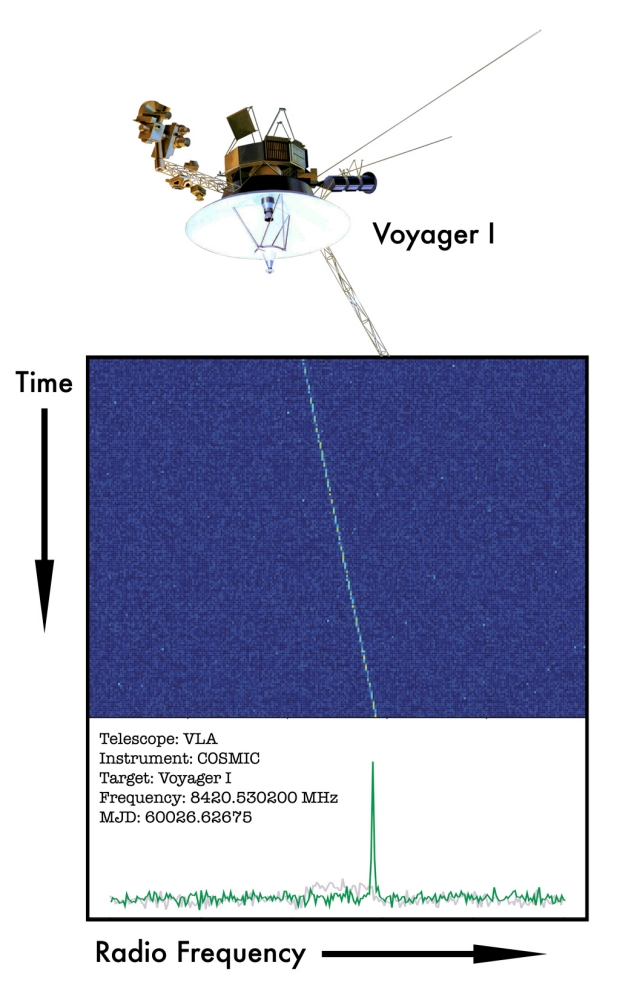
Voyager as Technosignature
Here’s an image that brings out the philosopher in me, or maybe the poet. It’s Voyager 1, as detected by a new processing system called COSMIC, now deployed at the Very Large Array west of Socorro, New Mexico. Conceived as a way of collecting data in the search for technosignatures, COSMIC (Commensal Open-Source Multimode Interferometer Cluster) taps data from the ongoing VLASS (Very Large Array Sky Survey) project and shunts them into a receiver designed to spot narrow channels, on the order of one hertz wide, to spot possible components of a technosignature.
Technosignatures fire the imagination as we contemplate advanced civilizations going about their business and the possibility of eavesdropping upon them. But for me, the image below conjures up thoughts of human persistence and a gutsy engagement with the biggest issues we face. Why are we here, and where exactly are we in the galaxy? In the cosmos? Spacecraft like the Voyagers were part of the effort to explore the Solar System, but they now push into realms not intended by their designers. And here we have the detection of doughty Voyager 1, still working the mission, somehow still sending us priceless information.

Image: The detection of the Voyager I spacecraft using the COSMIC instrument on the VLA. Launched in 1977, the Voyager I spacecraft is now the most distant piece of human technology ever sent into space, currently around 14.8 billion miles from Earth. Voyager’s faint radio transmitter is difficult to detect even with the largest telescopes, and represents an ideal human “technosignature” for testing the performance of SETI instruments. The detection of Voyager’s downlink gives the COSMIC team high confidence that the system can detect similar artificial transmitters potentially arising from distant extraterrestrial civilizations. Credit: SETI Institute.
Voyager 1 is thus a dry run for a technosignature detection, and COSMIC is said to offer a sensitivity a thousand times more comprehensive than any previous SETI search. The detection is unmistakable, combining and verifying the operation of the individual antennas that comprise the array to show the carrier signal and sideband transmissions from the spacecraft. The most distant of all human-made objects, Voyager 1 is now 24 billion kilometers from home. For one participant in COSMIC, the spacecraft demonstrates what can be done by combing through the incoming datastream of VLASS. Thus Jack Hickish (Real Time Radio Systems Ltd):
“The detection of Voyager 1 is an exciting demonstration of the capabilities of the COSMIC system. It is the culmination of an enormous amount of work from an international team of scientists and engineers. The COSMIC system is a fantastic example of using modern general-purpose compute hardware to augment the capabilities of an existing telescope and serves as a testbed for technosignatures research on upcoming radio telescopes such as NRAO’s Next Generation VLA.”
COSMIC is the result of collaboration between The SETI Institute (working with the National Radio Astronomy Observatory) and the Breakthrough Listen Initiative. The key here is efficiency – the technosignature search draws on data already being taken for other reasons, and given the challenge of obtaining large amounts of telescope time, an offshoot method of tracking pulsed and transient signals simply makes use of existing resources, with approximately ten million star systems within its scope.
Technosignatures are fascinating, but I come back to Voyager. We’ve gotten used to the scope of its achievement, but what fires the imagination is the details. It wasn’t all that long ago, for example, that controllers decided to switch to the use of the spacecrafts’ backup thrusters. The reason: The primary thrusters, having gone through almost 350,000 thruster cycles, were pushing their limits. When the backup thrusters were fired in 2017, the spacecraft had been on their way for forty years. The “trajectory correction maneuver,” or TCM, thrusters built by Aerojet Rocketdyne (also used on Cassini, among others), dormant since Voyager 1’s swing by Saturn in 1980, worked flawlessly.
In his book The Interstellar Age (Dutton, 2015), Jim Bell came up with an interesting future possibility for the Voyagers before we lose them forever. Bell worked as an intern on the Voyager science support team at JPL starting in 1980, and he would like to see some of the results of the mission stored up for a potentially wider audience. Right now there is nothing aboard each spacecraft that tells their stories. Bell quotes Jon Lomberg, who worked on the Voyager Golden Records and has advanced the idea of a digital message to be uploaded to New Horizons:
‘One thing I wish could have been on the Voyager record… is that I wish we could have had something of ‘here’s what Voyager was and here’s what Voyager found,’ because it’s one of the best things human beings have ever done. If they ever find Voyager they won’t know about its mission. They won’t know what it did, and that’s sad.’
And Bell goes on to say:
…let’s try to upload the Earth-Moon portrait; the historic first close-up photos of Io’s volcanoes and Europa and Ganymede’s cracked icy shells; the smoggy haze of Titan; the enormous cliffs of Miranda; the strange cantaloupe and geyser terrain of Triton; the swirling storms of Jupiter, Saturn and Neptune; the elegant, intricate ring systems of all four giant planets; the family portrait of our solar system. Let’s arm our Voyagers with electronic postcards so they can properly tell their tales, should any intelligence ever find them.
Could images be uploaded to the Voyager tape recorders at some point before communication is lost? It’s an intriguing thought about a symbolic act, but whether possible or not, it reminds us of the distances the Voyagers have thus far traveled and the presence of something built here on Earth that will keep going, blind and battered but more or less intact, for eons.

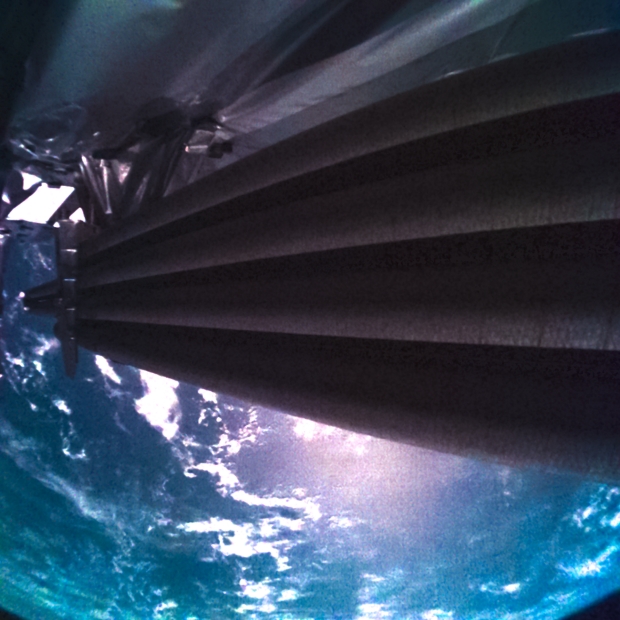
Working the Problem: Deep Space Repair
RIME (Radar for Icy Moons Exploration) is the first instrument ever deployed to the outer Solar System that can make direct measurements of conditions below the surface of an object. That makes it precisely tailored for Europa as well as Ganymede and Callisto, two other Galilean moons that also seem to have an internal ocean. Consider it a radar ‘sounder’ that can penetrate up to 9 kilometers below surface ice. RIME is a major part of why JUICE is going to the moons of Jupiter.
Consider it problematic as well, at least for the moment, while controllers working the JUICE mission try to solve an unexpected deployment issue. The 16-meter long antenna shows movement, but continues to have trouble in becoming released from its mounting bracket. The antenna is currently about a third of its full intended length, according to ESA, partially extended but still stowed away.

Image: Shortly after launch on 14 April, ESA’s Jupiter Icy Moons Explorer, JUICE, captured this image with its JUICE monitoring camera 2 (JMC2). JMC2 is located on the top of the spacecraft and is placed to monitor the multi-stage deployment of the 16 m-long Radar for Icy Moons Exploration (RIME) antenna. RIME is an ice-penetrating radar that will be used to remotely probe the subsurface structure of the large moons of Jupiter. In this image, RIME is seen in stowed configuration. The image was taken at 14:19 CEST. JMC images provide 1024 x 1024 pixel snapshots. Credit: ESA.
Given that two months of commissioning remain for the spacecraft, the agency is saying that there is abundant time to work the problem out, which may involve something as simple as a stuck pin, potentially sprung by warming the radar mount by rotating the spacecraft and turning the assembly into direct sunlight.
The memory of the Galileo probe to Jupiter hovers over the mission at least momentarily. Controllers never did free up Galileo’s high-gain antenna, though they were able to return outstanding data through ingenious use of its low-gain counterpart. Needless to say, the hope here is that RIME follows a different path and soon springs free.
In-flight adjustment and occasional repair are no strangers to deep space missions. We’re reminded of this also by the plan to save precious energy and keep Voyager 2 (and potentially Voyager 1) operational for a few years longer than previously thought possible. Both craft rely on RTGs (radioisotope thermoelectric generators) converting heat from plutonium into electricity, so that plutonium decay produces less power each year. Hence the need to turn off unneeded heaters and other systems to reserve power.
The new method: Use power heretofore reserved for a voltage regulator that triggers a backup circuit in the event of a serious fluctuation in voltage. Power is set aside in the spacecraft’s RTG for that purpose, but can be redirected to keeping the craft’s five science instruments operating until 2026. That gives up a certain safety measure, but even after 45 years in flight, the electrical systems on Voyagers 1 and 2 remain stable, so it seems a good gamble to produce further interstellar science. If the approach works for Voyager 2, it may be tried on Voyager 1 in the near future.
Suzanne Dodd is Voyager project manager at the Jet Propulsion Laboratory:
“Variable voltages pose a risk to the instruments, but we’ve determined that it’s a small risk, and the alternative offers a big reward of being able to keep the science instruments turned on longer. We’ve been monitoring the spacecraft for a few weeks, and it seems like this new approach is working.”
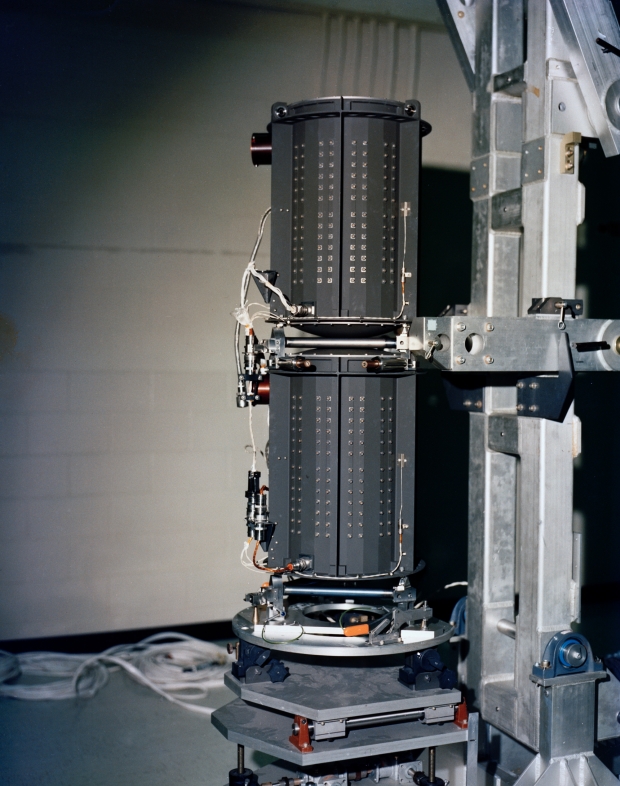
Image: Each of NASA’s Voyager probes are equipped with three radioisotope thermoelectric generators (RTGs), including the one shown here. The RTGs provide power for the spacecraft by converting the heat generated by the decay of plutonium-238 into electricity. Credit: NASA/JPL-Caltech.
Anything we can do to keep these priceless assets functioning is to the good. They are our only operational craft outside the heliosphere, a striking thought given their projected mission duration of a scant four years. Operating without one of its science instruments, which failed much earlier in the mission, Voyager 1’s power issues are slightly less pressing than its twin, but decisions about shutting down another instrument still loom, so the new RTG power draw may again come into play.

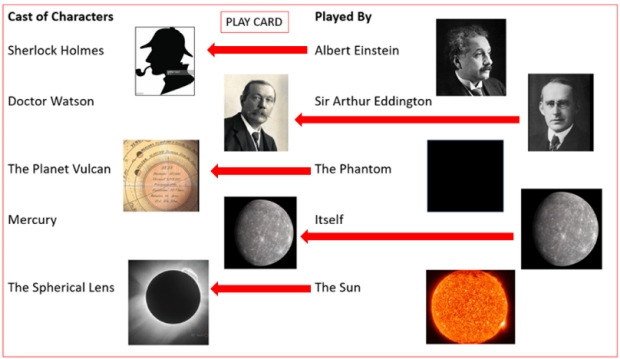
Part II: Sherlock Holmes and the Case of the Spherical Lens: Reflections on a Gravity Lens Telescope
Aerospace engineer Wes Kelly continues his investigations into gravitational lensing with a deep dive into what it will take to use the phenomenon to construct a close-up image of an exoplanet. For continuity, he leads off with the last few paragraphs of Part I, which then segue into the practicalities of flying a mission like JPL’s Solar Gravitational Lens concept, and the difficulties of extracting a workable image from the maze of lensed photons. The bending of light in a gravitational field may offer our best chance to see surface features like continents and seasonal change on a world around another star. The question to be resolved: Just how does General Relativity make this possible?
by Wes Kelly
Conclusion of Part I
At this point, having one’s hands on an all-around deflection angle for light at the edges of a “spherical lens” of about 700,000 kilometers radius (or b equal to the radius of the sun rS), if it were an objective lens of a corresponding telescope, what would be the value of the focal length for this telescopic component expressed in astronomical units?
The angle of 700,000 km solar radius observed from 1 AU, gives an arcsine of 0.26809 degrees. This is consistent with the rule of thumb solar diameter estimate of ~0.5 degrees.
Expressed in still another way, solar radius from this arcsine measure is 965 arc seconds. When the solar disc itself is observed to be about 1.75 arc seconds in radius, that’s where you will find the focus for this objective lens.
If we take the ratio of 965 to 1.75, we obtain a value 551.5. In other words, a focal point for the relativistic effect at 551.5 AU’s out. Thus, the General Relativity effect implies that light bent by the sun’s gravity near its surface radius is focused about 550 AUs out from the sun. And like the protagonist of Moliere’s 16th century comedy play, as I run off to tell everyone I know, I discover a feeling akin to, “For more than forty years I have been speaking prose while knowing nothing of it.”
This could be a primary lens for a very unwieldy telescope. True, but not unwieldy in all manners. When we consider the magnification power of a telescope system, we speak of the focal length of the objective lens over that for an eye piece or sensor lens focal length. And habitually one might assume it is enclosed in a canister – as most telescopes sold over the counter at hobby stars are. But it is not always necessary or to any advantage. Consider the largest ground-based optical reflectors, or the JWST and radio telescopes. Their objective focal lengths extend through the open air or space. The JWST focal length is 131.4 meters or taller than its Ariane V launch system. Its collected light reaches sensors through a succession of ricochets in its instrumentation package, but not through. a cylindrical conduit extending out from the reflector any significant distance to the front. [Note: The Jupiter deflection case mentioned above would make the focal length 100x longer.]
Continued Discussion

(Tables, Figures and References for Parts I and II are sequential).
In contrast with a 130-meter objective lens focal length, with 550 AU, any focal length for a conventionally manufactured “eyepiece” lens optical system of any size would have enormous magnification or light gathering potential. Were it a lens of 1 or 10 or 100 meter focal length at the instrument end of the telescope, with the “Oort Cloud radius sized” objective lens focal length (550 x 1.5xe8 meters = 8.2 x 10e8 meters) it would not matter much so far as interstellar mapping would be concerned now. We should add as well that the magnification is in terms of area rather than diameter or radius. In effect magnification is multiplication of projected surface area or surface light.
Given the above, issues that remain to be addressed related to the field of view.
1. The spherical lens (the sun) is a light source itself, which needs to be blocked out with a coronagraph on board the SGL spacecraft.
2. The signal obtained from the star (but especially the planet!) is “convoluted” by passage around the perimeter of the solar lens. This must be undone by a deconvolution process.
3. In application for examining an exoplanet in orbit around another star, the fix on the star must be either adjusted to center on the related planetary target or else the planet’s data must be extracted from an enormous extraneous data package.
On issue 1, there are many coronagraph techniques already applied in telescopes for blocking solar or stellar light sources. The Nancy Roman Space Telescope device when launched will be the state of the art and likely to influence SGL coronagraph design. For issue 2, it would be interesting to see a simple illustrative example (e.g., a sphere with a simple pattern such as broad colored latitudinal and longitudinal bands alternating in some patterns… a yellow or green smiley face?), transformed and then converted back. On issue 3, however, I believe that discussion below will provide more immediate insights.
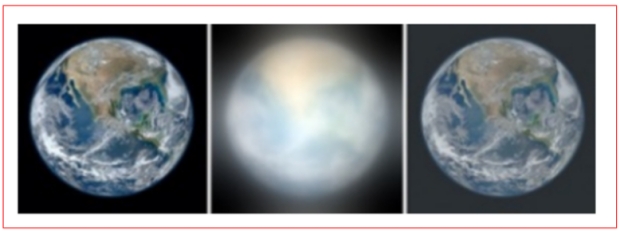
Figure-6 As noted in [7], a meter class telescope with a coronagraph to block solar light is placed In the strong interference region of the solar gravitational lens (SGL) and is capable of imaging an exoplanet at a distance of up to 30 parsecs with a few 10-km scale resolution on its surface. The picture shows results of a simulation of the effects of the SGL on an Earth-like exoplanet image.
Left: Original RGB (red, green, blue) image with a 1024 x 1024 pixel array.
Center: Image blurred by the SGL, sampled at an SNR (signal to noise ratio) of 103 per color channel or overall SNR of 3 x 130.
Right: Result of image deconvolution.
In Reference 7 by Turyshev et al., with Figure-7, potential benefits of an SGL telescope are illustrated with a targeted planet similar to the Earth within a range of 100 light years. What follows is a reference point which we would like to examine as well; in this case, with a specific range (10 parsecs) to illustrate engineering and operational questions, concerns or trades. In archives, see also [ref. A12].
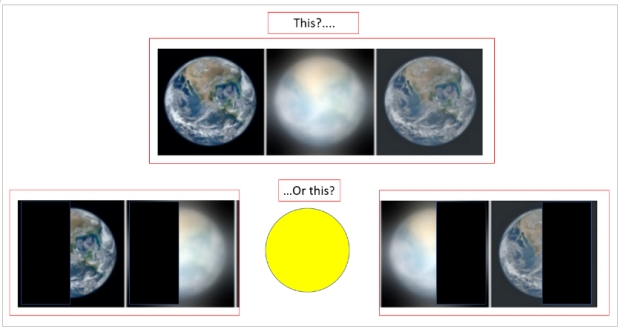
Figure-7 Contrast of benefits illustration with planet observed with an orbital plane in the line of sight of the GLT.
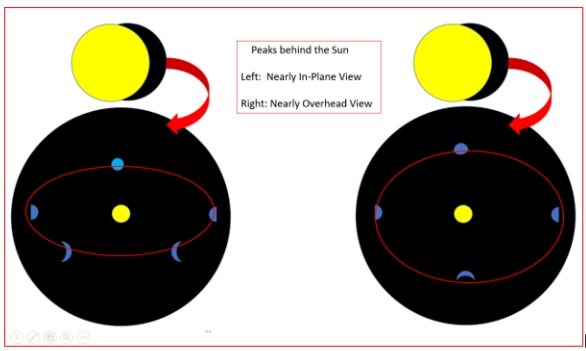
Figure-8 Observation of a target planet with an orbital plane inclined to the line of GLT line of sight.
Left side, with perpendicular to the orbital plane tipped forward, we can observe crescent phases similar to the planets orbiting the sun interior to the Earth, but at low angles, the illuminated exoplanet face is not illuminated. On the aft side of the sun it is in full phase, but perhaps experiencing significant glare. On the right side, with higher inclination, the exoplanet appears as a cat’s eye above the center point; below, as a crescent rotated at a right angle to its path.
What to Do about Slew?
As for deploying a telescope out into the Oort Cloud out to ~550 AUs: This seems explicable and feasible with a combination of conventional propulsion and orbital mechanics taken to a higher state of the art, nuclear thermal, nuclear fusion electric or thermal, sized based on constraints such as mass, mission duration, infrastructure and finance. It is assumed here, by this aerospace engineer, that trajectory, propulsion, navigation and guidance issues of deployment with resources not yet available but will be with larger spacecraft assembled and tested in the future. However, operational issues of this baseline or reference mission, I would still like to explore. In pursuit of this, we will add a reference target (perhaps the first of an enlarging set), an exoplanet similar to the earth in a solar system similar to ours at a viewing distance used to set stellar absolute magnitudes, a distance of ten parsecs.
Now if a stellar system were ten parsecs away or 32.26 light years off, the maximum radial offset of an Earth-like planet from a Sol like star (1 AU) would be 0.1 arc seconds. Hence, the Earth analog would be in the “nominal” field of view (FOV) but the FOV would encompass a radius of 175 AUs – If the center of the nominal FOV can be considered the center of the target star. The stellar absolute magnitude measure distance (10 parsecs ) is a middle distance for this exercise and a parsec (3.23 light years), also basic to astronomy, could be considered a minimum just below Alpha Centauri distance (4.3 light years).
However, FOV behind the sun used for now, might be misleading or unclear in these circumstances. Because it is not clear to me how much of the blocked celestial sphere is transferred back via the gravity lens phenomenon. In this analysis, without full understanding of how the coronagraph or convolutions will work, I am unsure whether there is any control over what the steradian field behind the sun will be; whether it can be entirely controlled. Focusing on the star could provide all the 175 AU radius in the field of view, or some fraction thereof. But if centering on a planetary target can limit the wasted scan area, I highly recommend such.
For argument’s sake, of this celestial “blockage” region, it could range from the infinitesimal to the whole. The image obtained might be treated akin to a point source from which we might extract image data somewhat akin to extracting the spectrum of a similar un-dimensioned source. Or there might be several different deconvolution methods which provide options. But the aspect that concerns me here is how one searches for a point source in this so-called FOV, more characterized by the blockage of the sun’s angular width. The FOV might be described as an area within an FOB, a field of blockage. Whether discerned directly without need of a deconvolution – or not – at ten parsec distance the field of “blockage” (FOB?) would include a radius of 175.5 AUs in the 17.5 arcsecond maximum field of view.
The diameter of a G2V sun like ours is about 0.01 AU and a terrestrial planet like our own is 0.01 of that. And then what kind of transformation or convolution would be required to take the information from the other side and convert it back into an image? An image we would recognize as a planet with continents, oceans and clouds. Not knowing for sure, I suspected that if the position of the target planet were known, it would make more sense to focus the telescope on it rather than the star itself. On the other hand, if obtaining a coronagraphic blocking of the star required centering on the star, and capturing the planet required processing the thick ring around the star, then the total amount of data processing could become enormous – as the following table shows.
In terms of terrestrial planet viewed area vs. that of the 1 AU radius region and the 175 AU radius encompassing the entire celestial pane blocked by the sun, the ratios are 1 to 500 million and 168 billion respectively. Depending on the resolution sought for the planetary analysis ( e.g., 10 kilometer features distinguishable), then data bits characterizing individual “squares” of smaller dimensions must be processed. For present purposes, we can select ten kilometers for illustration.
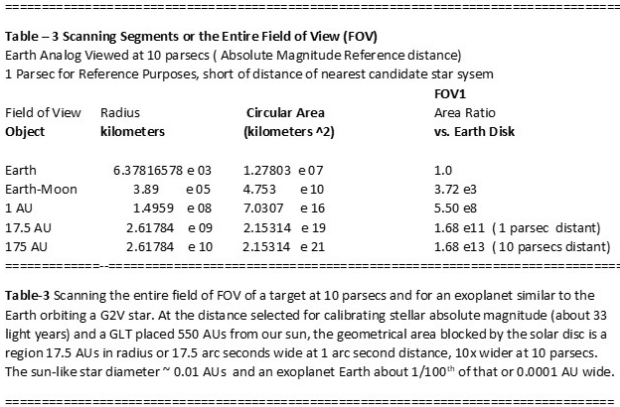
Table-3 Scanning the entire field of FOV of a target at 10 parsecs and for an exoplanet similar to the Earth orbiting a G2V star. At the distance selected for calibrating stellar absolute magnitude (about 33 light years) and a GLT placed 550 AUs from our sun, the geometrical area blocked by the solar disc is a region 17.5 AUs in radius or 17.5 arc seconds wide at 1 arc second distance, 10x wider at 10 parsecs. The sun-like star diameter ~ 0.01 AUs and an exoplanet Earth about 1/100th of that or 0.0001 AU wide.
As the NIAC Phase II Report and AIAA journal article [7 and 8] indicate, targeted resolution objectives are on the order of 10 kilometers, indicative of sampling cells of lower dimensions. A one-kilometer-wide sample cell we select for sake of argument. However, with each observed cell, the GLT telescope instrument suite will include 3 -5 color band sweeps (e.g., ultraviolet, blue, yellow, red, infra-red) which would include intensity levels. A spectrometer could also seek evidence of discrete spectral lines or molecular bands. So, for each square kilometer scanned, there could be considerable binary coded data for the telemetry link. More than one data-bit for sure associated with each polygon of space scanned by the SGL telescope. If each polygon has a location defined in a 2-dimensional grid, then that point likely has two 32 or 64-bit position assignments; then each color filter has an intensity. In addition, if spectral lines are tracked another databit code will be assigned to that point as well.
Processing the FOV indiscriminately with focus on the star is like searching for a needle (or data) in a haystack. Tracking the planet itself could eliminate orders of magnitude of excess data processing. On the other hand, slewing at 550 AU circular orbit entails 40,000 km magnitude oscillations over a year to follow the target, distances equivalent to a tenth of Earth-Moon separation, but an expenditure of propulsive resources. Consequently, this would become at least one resource trade between data handling and maneuverability. One possible solution would be multiple telescopes formation flying over “seasonal” tracking points a quarter of orbital revolution apart in the projected orbital track.
The scenario for deploying the telescope assumes considerable outbound velocity accumulated in the form of continuous low thrust acceleration. Consequently, on station a very large radial velocity will remain. Remarkably, at 550 AU distance, circular orbit velocities are still over a kilometer per second ( e.g., Earth orbital about 29.7 km/sec over square root of 550, about 1.27 km/sec). With the Earth-based example at 10 parsecs and the requirement to cover 40,000 km back and forth within about 6 months, the corresponding constant velocity would be 0.0025 km/sec to hold the alignment. This type of slewing would work better with a more rapidly orbiting exoplanet located in the HZ of a red dwarf. But the M star case would require more frequent reverses of direction. Significantly, were we to do this exercise for a target at 1 parsec such as the Alpha Centauri stars, the oscillations would be ten times larger (400,000 km) or about the distance to the moon.
Additionally, the rotation rate about the planetary axis could be star synchronous or, as with the Earth or Mars, much faster than the orbital revolution. There could be moons in its near vicinity. All these are natural considerations for a habitable zone exoplanet survey. And reasons that features on the exoplanet surface could become blurred. Other cases would generate different requirements, no doubt. And all this will affect how long it will take to process square kilometer data sets into each of their relevant maps.
Beside stellar glare, galactic background needs to be considered too. A dark field behind the target star would be preferable as well, achieving a higher signal to noise ratio. It would be a shame if threshold levels for observing a planet vs. magnified stellar backgrounds could not be assessed prior to flight. A potential problem making out the planet against the background would make a planetary ephemeris important; linkage to home base guide telescopes directing the GLT pointing, where in a sense the GLT will be blind. We have discussed just an Earth analog so far, but HZ targets at cooler K and M stars as well as hotter F main sequence stars could possess eye-opener properties too.
Several decades ago, during an undergraduate satellite design project I participated as the communications engineer – and then space navigation assignments called on putting on that hat again. An interesting experience each time and I found some overall equations that formulated relations among distance, signal to noise thresholds, signal rates and power required to stay in touch at both ends, spacecraft and the Deep Space Network. Unfortunately, I lost our first team’s final report in a flood, not of information like that discussed, but of tropical storm water. But it is not necessary to reconstruct the methods found then. At this date there is now an old literature base for communications with spacecraft situated in deep space, thanks to publications of the Jet Propulsion Laboratory, illustrative examples such as Voyager and other Jupiter bound spacecraft, even earlier spacecraft examined as if they were beaming from there and received with network capabilities of a given epoch (see Figure 9).
Figure-9 Figure-9 A diagram from Ref. 5 pegs down one end of the trade issues, chronological increases in data rates obtained from spacecraft in Jupiter vicinity. Reception is associated with 5.2 AU distance from the sun (varying with the Earth) vs. the 550 AUs or more anticipated for the GLT. On one axis, acquisition data rates are shown. For each spacecraft that sets out on these Jovian missions (some, of course, actually did not), a liftoff limit on power or data rate can be assumed for the spacecraft or observatory. Once launched, most of the growth was likely at the Earth based part of the communication link.
In comparison with attenuation of signals from the Jovian system at 5.2 AU for the various systems shown in the Figure-9 JPL diagram, signals 100x further out will be decreased in strength to ~1/10,000th or less with movement beyond 550 AU. Consequently, data rates shown in the diagram for various extent technologies will be dropped by a factor of 1/10,000th or 1.0 e-04 as well.
Depending on when such an SGL space observatory will be launched, some technologies will improve data transmission rates or storage capacities with respect to mass density or power required. Other technologies likely will not experience similar trends. For example, it is unclear what new Deep Space Network type tracking facilities will be employed in support of the SGL mission. However, if the data load is driven by a full scan of the equivalent of the solar angular area or FOV, the spacecraft system requirements for data storage and transmission are increased enormously.
On the other hand, as shown, slewing from the stellar focal point to a planetary position will require propellant resources and attitude control increases over those for the stellar fix. Even at 550 AU, there is a 1.28 km/sec characteristic circular orbit velocity. And depending on time of flight to outpost station delivery, in coast the spacecraft can be considered on an extremely hyperbolic heliocentric path. Consequently, fixed on a target planet, low thrust would be required without planet tracking even to maintain stellar focus.
My own quick assessment is that narrow field of view scanning in the planetary vicinity as it tracks around the star in some arbitrary orbital plane is the better procedure. The actual orbital plane’s normal could be inclined by some angle to the line of sight (See Figure 8). Hence, a circular path would be perceived as an elliptical projection; more complex if actually eccentric to a considerable fraction. But with a mean likelihood of 45-degree inclination and circular orbit, half phases would appear at greatest stellar elongation. Near the line of sight, a cat’s-eye would appear behind the star and a crescent in front with lowest elongation and greatest glare. With zero inclination of the planet, we are bound to learn much about its northern hemisphere and much less about its south, depending on its rotational axis alignment.
Now if a stellar system were ten parsecs away or about 33 light years off, the maximum radial offset of an Earth-like planet from a Sol like star (1 AU) would be 0.1 arc seconds. Hence, the Earth analog would be in the “nominal” field of view (FOV) but the FOV would encompass a radius of 17.5 AUs – If the center of the nominal FOV can be considered the center of the target star.
FOV, used for now, might be misleading in these circumstances. Because it is not clear to me how much of the blocked celestial sphere is transferred back via the gravity lens phenomenon.
For argument’s sake, of this celestial “blockage” region, it could range from the infinitesimal to the whole. The image obtained might be treated akin to a point source from which we might extract image data somewhat akin to extracting the spectrum of a similar un-dimensioned source. So the aspect that confuses me here is how one searches for a point source in this so-called FOV, more characterized by the blockage of the sun’s angular width. The FOV might be described as an area within an FOB, a field of blockage.
In this situation, there would have to be some fore-knowledge of where the target planet should be. You would need a tracker observatory probably closer to Terra home. You still need a means to locate a body orbiting an object about a hundredth of an AU in diameter and in turn a planet about 1/10,000 of an AU wide. To relay information from a stellar observatory not experiencing this occultation by the sun to 550 AUs out, the lag would be about 3.174 days based on the speed of light.
And then, presumably, the observatory would need to slew toward this planetary target from the reference point of the stellar primary – or perhaps even the center of mass in a binary system. Alpha Centauri could be such an example.
A Mission for One Star System and Exoplanet or More?
Additional trade issues to consider are related to completion of observation and characterization of one planetary system. Perhaps there is more than one planet (or a moon) in a target system to study. But there is also the issue of observing more than one planetary system. Minimal angular separation of two “good” candidate systems in the celestial sphere would have to be weighed against the “excellence” of an isolated stellar system with no potential for a phase II mission elsewhere, say within one degree of circular arc. Faced with such a dilemma I would hope that observing the isolated system over years until system deactivation will be well worthwhile.
At this writing we are aware of about 5000 exoplanets with attributable features, providing a range of reasons for continued or closer observation. Like the other design issues described above, eventually there will be the dilemma of which exoplanet or planets to select.
In terms of steradians, the whole celestial sphere has an area of 4 ? units. With some experimentation I discover that it is possible to determine the equidistant position of any number of stars – which can illustrate the dilemma of deciding how to deploy the SGL Telescope. The celestial arc A between equally spaced stars of a given number n can be described with the answer in radians convertible to degrees. Once n equals or exceeds 3, the equidistant points can be viewed as vertices to equilateral and equiangular spherical triangles of given arc segments, the latter the significant parameter. The total of 5000 exoplanets is not distributed with an equal spacing, but there is an element of likelihood with the fractional degree separation overall. And, of course, a smaller selection of select exoplanet systems will have wider individual separations overall, but perhaps a few will be less than a degree apart. For the case of ten parsec distant planetary system we noted that a traverse to cover 17.5 AUs encompassed about 400,000 kilometers at 550 AU. A one degree traverse is 205 times as large but it does not have tracking determined maneuver velocity requirements.
It is likely that by some set of selected parameters, several exoplanets can be selected for further scrutiny. However, if several parameters are involved and a couple of candidates or alternates can be identified in proximity, it is possible that two close star systems could outscore focus on one, even if it generally acknowledged the best, but located on the wrong side of the sky for total mission benefit.
Consequently, the mission analysis could become more complicated as time passes with a larger and larger selection of nearby systems identified with one or more planets.
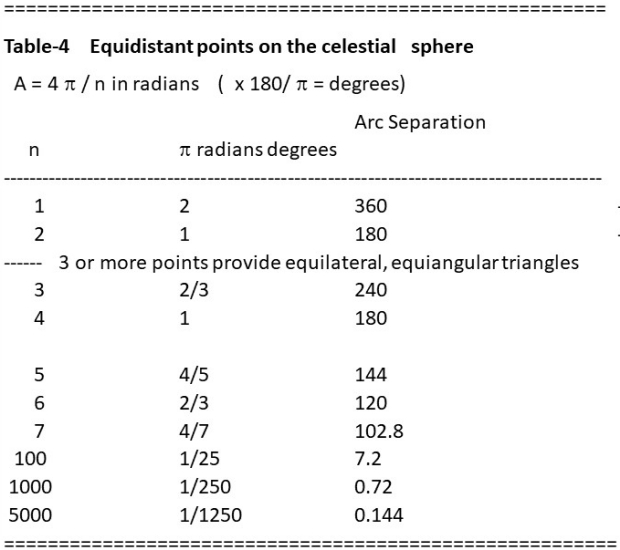
What would the parameters tend to be to warrant such a trade? Even if there is no evidence of life, an exoplanet of exceptional nature could transcend parameters associated with habitable zone parameters or signs of life. And for examination of signs of life, our knowledge will have to exceed such identifications as diameter, albedo and placement in a habitable zone: atmospheric composition, nature of hydrosphere, traces of processes similar to terrestrial ones… Cost benefit issues too of propulsion and maneuver to survey two planets would need to have an identifiable threshold against the additional spacecraft weight budget for propulsion. If the two candidate systems are far apart, then the choice might be easier in a way if it requires launching two distinct missions.
Whether going for two exoplanets separated by a degree or more is worthwhile, is difficult to ascertain at this early stage. But the determination will depend on establishing criteria for a trade. To first order it will depend on how outstanding signs of life might be within a future database of exoplanets. And if not clear, which parameters of an exoplanet or a maneuverable spacecraft should be considered and with what weight. Reflecting on an earlier orbital application proposal, Arthur C. Clarke suggested geosynchronous orbit for a single communications relay station, elaborated as a call center with humans at switchboards. Instead, we have numerous geosats with no one aboard. It could be that SGL spacecraft will proliferate similarly and for several purposes. At the very least, we can be thankful to be able to consider such possibilities, coming from a time decades back when exoplanets were simply considered fantasy like Spock’s planet – or more locally – Lescarbault’s and Le Verrier’s Vulcan.
References for Part I and Part II
1.) Pais, Abraham, Subtle is the Lord … The Science and Life of Albert Einstein, Oxford University Press, 1982.
2.) https://www.stsci.edu/jwst/science-execution/observing-schedules
3.) Vallado, David A., Fundamentals of Astrodynamics and Applications, 2nd edition, Appendix D4, Space Technology Library, 2001.
4.) Moulton, Forest Ray, An Introduction to Celestial Mechanics, 2nd Edition, Dover, 1914 Text.
5.) Taylor, Jim et al. Deep Space Communications, online at https://descanso.jpl.nasa.gov/monograph/series13_chapter.html
6.) Wali, Kamshwar, C., Chandra – A Biography of S. Chandrasekhar, U. of Chicago Press, 1984.
7.) Turyshev et al., ”Direct Multipixel Imaging and Spectroscopy of an Exoplanet with a Solar Gravity Lens Mission,” Final Report, NASA Innovative Advanced, Concepts (NIAC) Phase II.
8.) Helvajian, H. et al., “Mission Architecture to Reach and Operate at the Focal Region of the Solar Gravitational Lens,” Journal of Spacecraft and Rockets, American Institute of Aeronautics and Astronautics (AIAA), February 2023, on line pre-print.
9.) Xu, Ya et al., ”Solar oblateness and Mercury’s perihelion precession”, MNRAS, 415, 3335-3343, 2011.
A1.) Archives: In the Days before Centauri Dreams… An Essay by WDK (centauri-dreams.org)
A2.) Archives: A Mission Architecture for the Solar Gravity Lens (centauri-dreams.org)
Here in Houston, the University of Houston, Clear Lake Physics and Astronomy Club had a recent meeting when the sky was obscured by clouds and the president had asked in advance, just in case of such circumstances, would I have any presentation I could give that night. There were some other ones that had grown all out of control, so I decided to start on a fresh topic. This article grew out of the evening presentation and consequently, it is dedicated to the club and its members.
WDK
13 April 23


Sherlock Holmes and the Case of the Spherical Lens: Reflections on a Gravity Lens Telescope (Part I)
A growing interest in JPL’s Solar Gravitational Lens mission here takes Wes Kelly on an odyssey into the past. A long-time Centauri Dreams contributor, Wes looks at the discovery of gravitational lensing, which takes us back not only to Einstein but to a putative planet that never existed. Part II of the essay, which will run in a few days, will treat the thorny issues lensing presents as we consider untangling the close-up image of an exoplanet, using an observatory hundreds of AU from the Sun. Wes has pursued a lifetime interest in flight through the air, in orbit and even to the stars. Known on Centauri Dreams as ‘wdk,’ he runs a small aerospace company in Houston (Triton Systems,LLC), founded for the purpose of developing a partially reusable HTOL launch vehicle for delivering small satellites to space. The company also provides aerospace engineering services to NASA and other customers, starting with contracts in the 1990s. Kelly studied aerospace engineering at the University of Michigan after service in the US Air Force, and went on to do graduate work at the University of Washington. He has been involved with early design and development of the Space Shuttle, expendable launch systems, solar electric propulsion systems and a succession of preliminary vehicle designs. With the International Space Station, he worked both as engineer and a translator or interpreter in meetings with Russian engineering teams on areas such as propulsion, guidance and control.
by Wes Kelly

Part 1. “Each of the Known Suspects Has an Alibi Related to His Whereabouts.”
[This article originated with an inquiry from our local astronomy club for a talk during an indoor meeting anticipating a cloudy sky.]
Among topics arising on Centauri Dreams, reader response often turns to investigation: the original scientific reports plus surrounding evidence, the basis for many of the website’s entries. And when a topic is unfamiliar or on a frontier of knowledge, reader investigation can be a matter of playing catch up, as I can attest. Fair enough. Scientific observations, data interpretations or hypotheses… Take the matter of heading out to deep space to collect light from the other side of the sun and then deconvolute it to extract the image of an exoplanet. The steps to this objective have to be judged individually or reviewed as stepping stones, connecting lines of inquiry… Or maybe going so far as to say, “All right. Now let’s just start all over…”
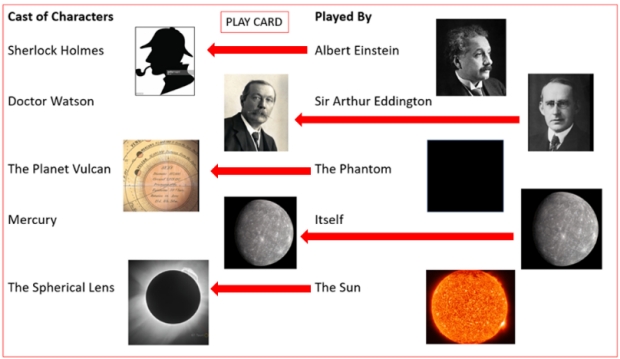
So, I did. With the result an attempt at integration, or else a short story.
And to what conclusion am I drawn? That there is significant linkage between the proposed solar gravitational lens (SGL) telescope to be placed out at 550 AU distance and (Envelope, please…) the planet Vulcan.
The one from which the Starship Enterprise first officer supposedly arose? The logician with a name spelled like a noted 1960s contemporary pediatrician? No, that is just a ruse, “to cloud men’s minds”, an inhabitant of a fictitious exoplanet. The one of concern here I first heard of before Gagarin took off from Baikonur. It was in some science fiction anthology at the local library or bookmobile. I can’t recall who wrote it, but it was probably an anachronism by the time it went to press in the pulp magazines originally, at least a decade or two before a Redstone rocket was launched. And as a grammar school kid, I never finished it. A piloted trip to a planet inside Mercury’s orbit was an imaginary rabbit hole into which I was either unwilling or not patient enough to complete the full dive. Nor evidently did Einstein biographer Abraham Pais, in which I thought all things related to Albert would reside in his book, Subtle is the Lord…” [1]. I see no reference to Vulcan in his index.
In a less cynical era, I remember a spoken introduction to discoveries reported in the news. It was communicated on long train or bus rides or standing in an interminable queue, the oft optimistic assertion that there existed a benign, secret, scientific conspiracy (something Sir Arthur Conan Doyle might have joined or devised) to make life better for everybody. Largely, or at least not universally, since sometimes, some party might view a word-of-mouth development as the business end of a new and special gun barrel. More likely though, the secret org would have to get back with us much later – if at all. But whatever the development was, and if it coincided with a continuing concern, the reader, radio listener or TV news watcher could feel obliged to come up to speed on the subject. Since that halcyon era despite the changes in media… “Do you know what they are doing now?” …
Plus ça change, plus c’est la même chose.
As an engineer with a classical mechanics background, shunning issues of electro-magnetism or general relativity but interested in astronomical developments all the same – and especially for the past several decades, those related to exoplanets, I’ve climbed over such obstacles anyway. And on the issue of the field of view for a GR telescope looking backward toward the sun reliant on some convolution to see an exoplanet, I got stuck like a donkey with a cart. In an earlier article for Centauri Dreams [Archive, A1], I gave an account of those pursuits, of examining what became known as habitable zones (HZ) around binary system stars, converting terrestrial trajectory tools I had been using for more sundry inquiries to address that distinct celestial 3- body problem. This was at about the time in the 1980s when no exoplanets were known of anywhere. So, to some degree, it was all in fun. Alpha Centauri looked more promising for stability than Procyon, and Procyon better than Sirius – which was terrible. Beta Pictoris, back in those days had a circumstellar disk of dust according to the Infra-Red Astronomical Satellite (IRAS) of that era. Just maybe something could be forming in the midst of it.
So, here we are decades later. The James Webb Space Telescope was in development for so long, that it too in conception had preceded the discovery of exoplanets; but its remarkably wide aperture for a space telescope and its IR sensitive instrumentation, originally loaded aboard for cosmological questions, adapted very well to follow-up investigations of a host of exoplanets in its visual and near IR bands. These objects were discovered by other instruments in space or on the ground; detected indirectly at first through stellar radial velocity spectral shifts, then stellar transits, primary astrometric shifts in a few cases, a couple of direct images by the Hubble Space Telescope and so forth.
If one checks the JWST website [2] and its observing schedule, exoplanet observations entail a large fraction of the space telescope’s time. Not necessarily the search for new ones, but definitely follow-up campaigns initiated at other observatories: Kepler and TESS space telescope transits, stellar radial velocity cases obtained from large ground-based observatories on mountain tops or high desert plateaus, and the astrometric detections obtained from the Hipparcos and Gaia space telescopes for stars that possess periodic oscillations against the celestial background.
As for exoplanet detections based on gravitational lensing, I suspect that JWST’s “hands” are largely tied since one needs literally an alignment of the planets and stars. This last mysterious concept – relativistic micro-lensing as practiced thus far – appears to give an exoplanet population sampling. A survey technique that penetrates deeper into this galaxy and local ones than would be possible if light were not bent and magnified by stars very close to the line of sight, often also producing a ring effect around a gravitational mass. In many cases, light of distant objects such as galaxies and star clusters deeper in space can be extracted from distorted images such as annular rings, no mean feat of transformation and data processing itself. An image is distorted or convoluted and applied mathematical formulas “deconvolute” them – if they can. But now, there is the possibility of applying these last-mentioned features and techniques to scrutinizing specific exoplanets, ones that are selected and not the luck of the draw.
How did this state of affairs come about? Well, we can start with the planet Vulcan. If we consider this hypothetical planet for a few moments, then General Relativity seems a little less miraculously sprung from Olympian brows. But whether you are thinking of the exoplanet home of Star Trek’s Spock or the planet on an inside track with respect to Mercury, in both cases we are dealing with phantoms. Note that planet Vulcan’s parameters do not appear in Table-1.
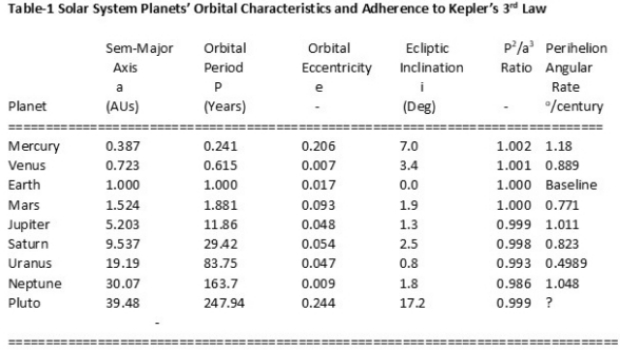
Table-1. Orbital properties of planets Mercury through Neptune (+ Pluto) in terms of their semi-major axes in Astronomical Units, periods in Earth years and orbital eccentricity. The second to last column, using these normalized terrestrial units of the first two columns, shows how closely they adhere to Kepler’s 3rd law: that an elliptical path around the sun has a constant proportion of period squared over the semi-major axis cubed. It is tempting to say radius squared, thinking of planets as near circular. But semi-major axis (as shown in Figure 1) governs calculation of average orbital velocity about a circumferential distance (v = 2 ? a / P). The last column, argument of perihelion advance in degrees per century, figures into the later part of our story. Pluto, whether true planet or not, should be included too for its perturbed P2/a3 value since it bears on searches for “Planet X”. And Mercury’s did once too for another putative planet.

As Table-1 and Figure 1 show, the motion that Kepler discovered is a fascinating example of three defining equations based on conservation of energy, conservation of momentum and the conic, defining an orbit in a 2-body system and on a plane. Johannes Kepler’s laws related directly to planets in planes occupied by the sun at a focal point as well. But the planets did not all exactly, or even necessarily, share the same plane – so long as the sun’s location occupied one common focal point shared by all of them. There were differences enough in the planets’ planar geometries so that their celestial coordinates have to be defined by additional elements beside semi-major axis, eccentricity and position of perihelion with respect to a single demarcation on the orbital plane such as the Earth-based ecliptic. To name some of the conventions used, there is the inclination of the orbital plane with respect to the ecliptic plane as a reference plane, the argument of the perihelion in terms of angular passage through that plane, and then the rotation of the plane about the sun in the reference plane with respect to a reference line (in the direction of constellation Aries) – the angle of the ascending node (See Figure 2).
Now if we had true Keplerian motion about the sun and a disregard of Newtonian mechanics, these values would remain immutable. But they don’t remain so. Due to the masses of the planets relative to the sun, there is a center of mass of the solar system, and when planets approach each other, they alter their paths as a first order “Newtonian” effect. So, not only do the orbital elements mentioned above have specific values, but they change over time, cyclically narrow in some cases such as eccentricity, or else with a complete rotation of features like the ascending node of a planet on the ecliptic plane, or the angular position of the perihelion with respect to that same ecliptic plane, rotating 360 degrees eventually. These parameters could be completing a revolution over centuries or millennia. And not always at the same rate, because with eight principal planets, their relative positions and resulting attractive forces are complex over time. Still, based on records kept back to Mesopotamian days, planetary perturbations of the Newtonian variety can be taken into account. But with closer and closer scrutiny beside the first order effects, in at least one case a secondary effect can be isolated as well. The polynomial approximations of the change of orbital elements with time are known as planetary ephemerides [3].
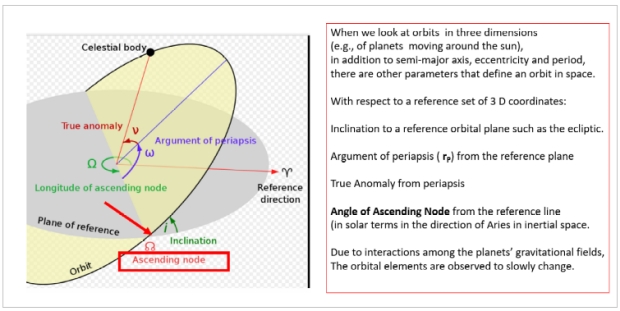
Figure-2 An Elliptical Orbit in Three-Dimensional Space
Secondary effects do need to be accounted for. If for nothing else, back in the 19th century, to obtain accurate nautical almanacs for marine navigation. [In one volume of the Patrick O’Brian series about the Napoleonic Wars, Captain Jack Aubrey was telling anyone who would listen about his sightings and time recording of the Galilean moons to determine his seaborne longitude.] So, one could ask, like Sherlock Holmes, one of 19th century’s most luminous fictional investigators, “These position discrepancies, what could account for this?”
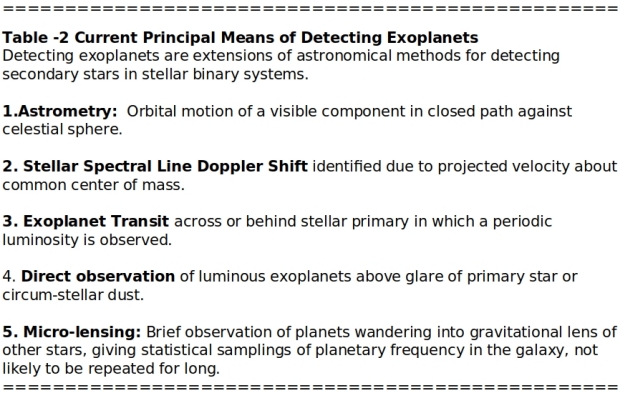
Table-2 The four above forms served to identify ~5000 distinct and repeatedly observed exoplanets thus far, providing orbital elements (partial or complete), in some cases, masses, surface temperatures, some chemical components. The fifth procedure’s service has been of a more fleeting nature, a keyhole into deeper space as a result of light bent and magnified by a gravitational field in the line of sight. On the other hand, if the proposed gravity lens telescope is installed as described, astronomy is set on a path toward learning relative minute details about what exoplanets it is able to target.
In the studies I mentioned of planets in binary star systems, the stable exoplanets would have very accentuated changes in eccentricity, periastron position or ascending node. Illustrative but too large in some cases, and the system breaks down into chaotic motion in which a planet could be ejected or graze a sun. Interesting in its own way, but this did not shed any light on relativistic effects, though I did have an opportunity to connect them one day. Toward the end of such hobby studies, I found that one of my work colleagues was pursuing his Ph.D. with a general relativity focus in his dissertation. We discussed the advance of argument of perihelion one day – and I explained that I had noted such behavior even with the sun and Jupiter affecting a third body such as Earth or Mars. It looked to me that it was about the right order. Sonny White agreed in a sense. He said that that was “about” right. Close, to some order, to what was seen in tables. But the famous relativistic effect observed with Mercury was an additional but slighter perturbation to the planet’s path. Remarkably, nineteenth century astronomers could distinguish this additional effect and, even in the absence of electronic computing, frequently fretted over it.
[*Before going Relativistic in this discussion, beside third bodies in Newtonian examinations of orbital motion, another source of disturbance from Keplerian motion worthy of note is in the subtle departure from spherical distribution of mass in the principal body around which another orbits, in particular from “oblateness”, the flattening of a spherical body so that the polar diameter is shorter than the equatorial. This too causes advances of the ascending node or the periapsis. For low earth orbits such as space stations, depending on their inclination, it could be 8 to 5 degrees per day in the fixed celestial sphere for the ascending node with inclinations between 28.5 and 51 degrees and circa 300 to 400-kilometer altitude. More massive and more oblate objects cause a faster rate. For Jupiter it would be about ten times faster using the same altitudes and inclinations. Compact, dense objects such as white dwarfs, neutron stars and black holes can experience rotational rates sufficient to engender oblateness and excite even faster advances. And yes, even in the case of the sun with its fluid volume and flattening. From time to time there are efforts to isolate the sun’s contribution to precession, e.g., [9]. However, we should note that Mercury does not skim the surface of the sun like space station examples above the Earth, Jupiter or condensed objects as mentioned above.]
Now when it came to planets, in antiquity and even up to Kepler’s time, one could say that there were “about” five genuine planets. Seven if you take into account eras or societies that were still debating whether an Evening and Morning Star could really be the same orb and then designated them as Venus or Mercury. Things stood about there until after both Kepler and Newton were gone. A number of mathematical astronomers, especially in France, observed departures from the Keplerian motion, to be sure. And in the case of Neptune, it was predicted before it was discovered with inferences gathered from its neighbors.
Verifying the Outer Planet discoveries, I note that William Herschel first observed Uranus (number 7) in March of 1781 and identified it as a planet. Quite a leap considering the intellectual inertia against such a premise until then.
Moreover, astronomers from the time of Hipparcos and Ptolemy with the Almagest charted “stars” where Uranus should have been when the observations were made. With good seeing conditions it can be visible to the naked eye. But the number of planets might have become a facet of natural science in Ptolemy’s time as well*. While studying Jupiter’s moons, Galileo had written Neptune into his own star charts, but this did not constitute its discovery. Rather, it was the other way around when 20th century astronomer Charles Kowal checked Galileo’s 17th century charts and found it there too, noted over a century before the genuine discovery event and then identified a century and a half after it was already noted as a planet.
[*The mental bias of having five planets wandering the sky for many centuries had a number of social features. Mythology and name designations in the sky seemed to complement each other. What allegorical role would a newly discovered planet assume if the mythic and astrological principal roles had already been taken? ]
Neptune’s discovery, however, was an event distinct from that of the seventh planet’s discovery process and a pivotal event in our story. In 1821, Alexis Bouvard published astronomical tables of the orbit of Uranus. Subsequent observations revealed substantial deviations from what the tables extrapolated, leading Bouvard to hypothesize that an unknown body was perturbing the orbit through gravitational interaction. In 1843, John Couch Adams began work on the orbit of Uranus using what data he had to point to a Planet 8, much of it supplied by Sir George Airy, the Astronomer Royal for Great Britain. Mathematical labors over 1845–1846 produced several different estimates for a new planet’s characteristics.
So, that was what was going down on one side of the English Channel or La Manche; this was what happened on the other. During 1845–1846, Urbain Le Verrier, independently of Adams, developed his own calculations but obtained little follow-up locally in France. But still, Le Verrier’s first published estimate of the planet’s longitude and its similarity to Adams’s estimate, caused some concern to Astronomer Airy that this search for an eighth could turn into a true horse race. Le Verrier grasped this too and then sent a letter urging Berlin Observatory astronomer Johann Gottfried Galle to search with the facility’s refractor.
“On the 23rd of September 1846, the day Galle received the letter, he discovered Neptune just northeast of Iota Aquarii, 1° from the “five degrees east of Delta Capricorn” position Le Verrier had predicted it to be, about 12° from Adams’s prediction, and on the border of Aquarius and Capricorn according to the modern IAU constellation boundaries.”
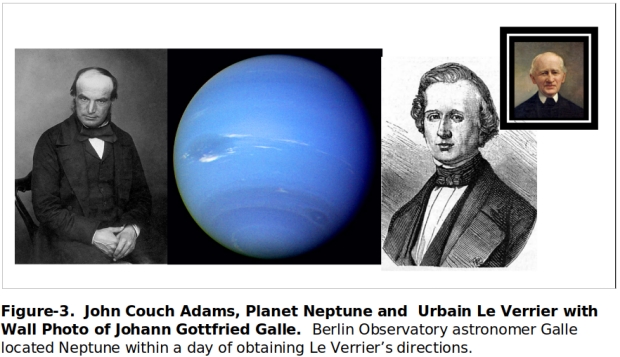
For our story, the issue is not whether it was Adams or Le Verrier who correctly calculated the position of an unknown planet, but the fact that it was beginning to become both demonstrable and fashionable. Also, in the telling of new planets discovered, if the story is followed close enough, one notes that Uranus was not predicted; instead, it was detected by observation or surveying the night sky. The game of new planet search and discovery continued in the outer solar system because Neptune had irregularities in its motions too. But discovery of Pluto weighed in insufficiently to explain this gas giant’s deviations from its presumed Newtonian path.
So, that was the situation mid-19th century moving out from Earth’s orbit among the “superior” planets, capable of unlimited azimuths above the sun as viewed from Earth. Now what about the situation with the other two, tracking interior to Earth’s orbit, Venus and Mercury? The ones with limited elongation from the sun.
Since Venus is the least eccentric of all the planetary orbits, it just might be that it is very difficult to see whether there is anything mysteriously moving its celestial longitude of perihelion any faster than it should. Yet actually I am aware of one paper published in the US decades back addressing this problem. Examining it one day, I noticed as well that the author had assumed an order of magnitude larger Venerian eccentricity than stated elsewhere. A virtuoso performance otherwise. However, the neighbor of Venus sunward indeed has eccentricity and inclination only rivaled by Pluto. And one does not have to wait 240 Earth years for a cyclic update; just 88 days. As a result, this was where the orbital number crunchers of the mid-19th century next turned their guns, a problem for which the astronomical practitioners of classical mechanics could roll up their sleeves: By their reckoning, the irregularities in Mercury’s motion needed explanation by the perturbative influence of a yet undiscovered innermost planet. And it became a now largely unknown namesake for the exoplanet home of Star Trek first officer Spock: the planet Vulcan.
It is often noted (e.g., with regard to UFOs) that it is near impossible to prove a negative; i.e., that an object or a phenomenon does not exist in some figurative dark woods. But demonstrations of existence do not always end happily either. In fact, the phantom planet Vulcan, the search target of many, was supposedly discovered by some. Buoyed by successful discovery of Neptune, Urbain Le Verrier was among those engaged. Even before Neptune’s discovery, despite what was said above, sightings of a planet interior to Mercury had occurred, practically since Galileo’s time. Likely, if anything they were sunspots. But Le Verrier’s success with Neptune now fueled 19th century observation campaigns around the world.
At the request of the Paris Observatory, Le Verrier in 1859 published a study of Mercury’s motion based on position observations of the planet and 14 solar transits. Discrepancies in observation vs. theoretical modeling remained; to the effect that its perihelion advance or precession was slightly faster than had been surmised. The observed value exceeded the classical mechanics prediction by the small amount of 43 arcseconds per century. Some unidentified orbiting object or objects inside the orbit of Mercury; either another Mercury sized planet or an unknown asteroid belt near the Sun could be responsible, the mathematical heirs of Lagrange and Laplace had concluded.
Sun or Son of Vulcan?
Emerging from a flock of observers reporting no success, amateur astronomer Edmond Modeste Lescarbault had searched for transits from 1853 to 1858 and thereafter more intently. He contacted Le Verrier in 1859, reporting a solar transit of the suspected planet on 26 March of that year observed from his home 70 kilometers southwest of Paris. With some reservation, but evidently not enough, Le Verrier endorsed Lescarbault’s report and proposed before the French Academy that the planet’s name be Vulcan. Lescarbault was elected to the French Legion of Honor. From calculations, Le Verrier described Vulcan thus: In circular orbit about the Sun at a distance of 21 million kilometers or 0.14 AU with a period of 19 days and 17 hours and inclination to the ecliptic of 12 degrees and 10 minutes. Seriously and specifically. As seen from the Earth, Vulcan’s greatest elongation from the Sun would be 8 degrees or about 16 solar diameters. This is worth remembering in what will follow.
Since we have noted a long full stop in discovering planets after evening and morning stars were unified into single entities, we have perhaps given mixed signals about inner or inferior planet calls of discovery, mostly since Galileo’s time and the use of the telescope. Sunspots were discovered and monitored shortly after Galileo’s astronomical reports. They had some tendency to wander, disappear or reappear, but they also indicated the rotation rate of the sun’s surface, about thirty days. Note that Le Verrier’s object orbits the sun quicker than the sun rotated still 0.14 AUs out and it was presumed to have an inclined path, but not as large as Mercury’s. At the very least, his solution distinguished itself from a sun spot.
There were many attempts to confirm the discovery, of course, and among efforts tending to confirm were those conducted by newcomers to this European sweepstakes, observatories in the United States. A team at the University of Michigan (1878), for example, obtained a positive. California’s Lick Observatory and other groups observed solar eclipses in 1883, 1887, 1889, 1900, 1901, 1905 and 1908 with no joy. Note about when this mostly fruitless search effort stopped?
A century or so after this campaign, our selective memories tend to suggest that Albert Einstein’s solution to Mercury’s odd behavior was an answer to a question that was never really asked. Yet it appears to be the contrary, a significant scientific issue; like say, a century later, where were all those neutrinos that the sun was supposedly producing in its core? And once Einstein tossed an explanation, over the fence, the scientific investigative process shifted its focus: “OK. We see what you are saying. Now how do we go about testing that?”
Vulcan as result slipped off the astronomical stage. Solar eclipses would no longer provide shade to search for a close-by planet, but for observing celestial position shifts of emerging starlight. Steamer tickets to remote sites for solar eclipses did not diminish. Now there was a different and perhaps more compelling motivation. Einstein was saying more and more about the strange properties of space, mass and time. There were several opportunities to test this, but the solar eclipse of 29 May 1919 turned out to be crucial. The Hyades constellation was near the ecliptic plane and a couple of stars seemed apt
Commanding General of Relativity?
Cambridge University astronomer (Sir) Arthur Eddington was not known from birth as an expert on General Relativity, but by the 1920s he was something of a GR phenomenon himself. There was a quote then in the English-speaking world that the only two individuals who understood the concept were Albert Einstein and Eddington, his English interpreter. Perhaps it originated with upper-level physics students remarking such to their juniors over lunch or in Cambridge halls. Better that than “General Relativity” Eddington, which surely would have provoked his ire. It should be noted that along with the post-war eclipse expeditions, Eddington was among the first to attribute sun energy reserves over geological epochs to hydrogen fusion and other nuclear reactions in its core. It was in answer to the enigma of how Earth’s geology suggested formation eons ago and stable heating since.
Eddington was also one of the few eyes and ears Great Britain had on science developments across the trenches of World War I; partly the result of his Quaker pacifist background and principles, partly due to Cambridge University’s efforts to retain him in its research community. On the continent Dutch physicist Willem de Sitter had communicated to Eddington in 1916 about Einstein’s work – and Eddington ultimately suggested to Einstein that he use his theory to calculate an answer to Mercury’s precession rate. Thus, in the English-speaking world in the 1920s no one was better situated to write about General Relativity. Except maybe Chandrasekhar. But that would be later; after a fitful period of work together at Cambridge. I referred back to a biography of Chandrasekhar [6] read a decade back for background not obtained on the 1919 GR test in the Pais biography of Einstein. And there was something right away. Chandra maintained Eddington’s selection to lead the expedition was not out of deference for a GR specialist, but pique over his WWI deferment from the general conscription (page 8) of the recent war.
Or, perhaps this reflected instead little faith for a successful outcome, or that this particular hypothesis held much of a future for physics. Ultimately, among Chandrasekhar’s many works was a biography of his mentor published in 1983 [7]. I look forward to obtaining it.
Einstein’s General Relativity propositions had already instigated previous efforts to observe stars in solar eclipse vicinity. A German effort arrived on station in Tsarist Russia (the Crimea) with unfortunate August 1914 timing; and then the group was held in detention, leaving finally with no results. After the war, opportunities to observe would appear; one along a track over the South Atlantic – if weather would allow. In fact, seeing conditions and equipment at both sites where Eddington’s teams set up camp (Principe’ Island off West Africa and Sobral in Brazil) were questionable at best and the initial results were regarded skeptically though the phenomenon passed the test of time.
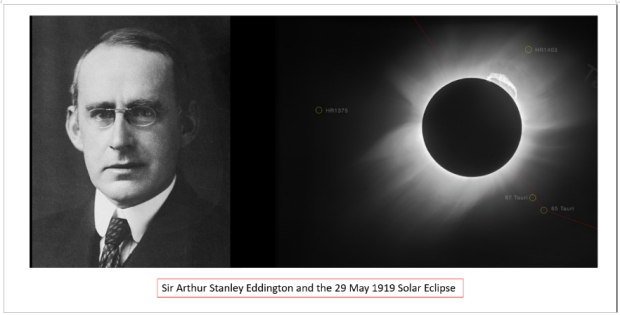
Figure-4. The experimental geometry that the solar eclipse provided was an opportunity to observe light emitted from a star of known position in the celestial sphere as it reappeared from behind the shining obstacle of the sun and the shadowing of the moon in a total solar eclipse.
Three possible results one could hypothesize based on the nature of light (i.e., photons moving at the speed of light but with no mass). Were photons akin to comets (which have mass) as they passed the sun at perihelion, they would be bent in a hyperbolic orbit. That’s one possibility (1). And if that were the case, then how could that be reconciled with the constant speed of light in a vacuum? [There was spectral shift to the red, however.]
But since the photons are assumed to have no mass, perhaps their paths would not be bent at all? That’s another (2). Struggling with the basics of physics in first year or later, I could see how such an outcome could strike one as just fine.
And then there was Einstein’s formulation of the space time continuum that had been in development over a decade (3). Einstein’s prediction was not a hyperbolic path, but it is bent based on its closest passage to the sun, the sun’s mass ( or that of any other possible perturbing object)…
A bend angle from the normal stellar line of sight (LOS) would be
?? = 4 GM/c2b,
where G is the universal gravitational constant, M is the mass of the sun, c is the speed of light and b is the closest light ray approach (distance) to the sun’s center, effectively the solar radius, in this case. Were it a conic, it would be perihelion. If, for example, we use Jupiter as a lens (rJ/rS ~ 1/10, MJ/MS ~ 1/1000), the deflection is about 1/100th the magnitude.
Since b is the only variable called out for the sun, other masses (M) would give different angles for the corresponding distances. Although this formula is approximate, it is accurate for most measurements of gravitational lensing, due to the smallness of the ratio rS/b, with rS the radius of the sun. If b is less than the rS value, we can presume that the light is blocked, unless some stellar light band can penetrate the solar medium. Larger, and the angle of deflection falls accordingly.
For light grazing the surface of the sun, the approximate angular deflection is roughly 1.75 arcseconds. This is twice the value predicted by calculations using the Newtonian theory of gravity. It was this difference in the deflection between the two theories that Eddington’s expedition, other 1919 ventures, and later eclipse observers would attempt to observe.
Well, if not simply Eddington’s, measurement of subsequent solar eclipses verified the stellar light deflection. And a first reaction to this news now might be like that of an observer of a shell game: “But what does this have to do with the orbital elements of Mercury?” A fair question. For our purposes it was confirmation of an overall theory that explained adjustments to Newtonian dynamics which affected both bodies of mass and massless particles in space. Space was warped by mass and energy and the tensor-based formulations of General Relativity accounted for both Mercury and the starlight during observed in eclipse. In math hierarchy tensors can be considered either as a more complex form of matrices and vectors or else the overall nomenclature of math forms of which matrices and vectors are of a simpler form. Beside general relativity, engineering applications include fluid mechanics and elastic solids in mechanics experiencing stress or loads. In workbooks such as Schaum’s Outline example problems are usually provided for all three applications. During the decade prior to the eclipse, one could say that Einstein worked such problems for himself and then with the aid of several European mathematicians. It was perhaps provident for all that several early eclipse expeditions were rained out, allowing Einstein to derive his best and final answer.
Across the Atlantic in the United States, Moulton’s well-known text on celestial mechanics went into its revised second edition [4] in 1921. It contains derivations and historical descriptions of many classical celestial mechanics problems; how they were solved. Included are many references to Le Verrier’s work, but not to the Vulcan episode. As well as I can reconstruct from this and other sources, Le Verrier might have used a technique developed by Gauss for the Vulcan study. On page 4 of Moulton, Einstein and the so-called Principle of General Relativity are discussed in the introduction’s section 5, concerning the laws of motion: “The astronomical consequences of this modification of the principles of mechanics is very slight unless the times under consideration are very long, and whether they are true or not, they cannot be considered in an introduction to the subject.”
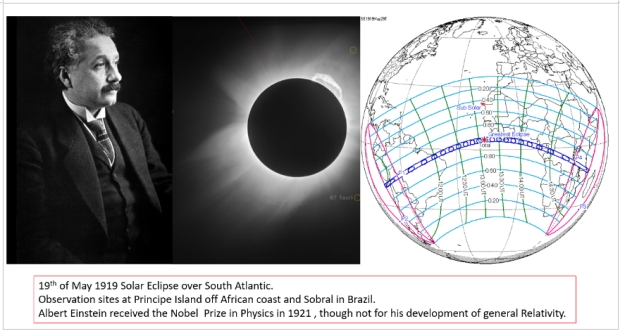
Figure-5 Albert Einstein, the Eclipse and its Track across the South Atlantic for 19 May 1919.
At this point, having one’s hands on an all-around deflection angle for light at the edges of a “spherical lens” of about 700,000 kilometers radius (or b equal to the radius of the sun rS), if it were an objective lens of a corresponding telescope, what would be the value of the focal length for this telescopic component expressed in astronomical units?
The angle of 700,000 km solar radius observed from 1 AU, gives an arcsine of 0.26809 degrees. This is consistent with the rule of thumb solar diameter estimate of ~0.5 degrees.
Expressed in still another way, solar radius from this arcsine measure is 965 arc seconds. When the solar disc itself is observed to be about 1.75 arc seconds in radius, that’s where you will find the focus for this objective lens.
If we take the ratio of 965 to 1.75, we obtain a value 551.5. In other words, a focal point for the relativistic effect at 551.5 AU’s out. Thus, the General Relativity effect implies that light bent by the sun’s gravity near its surface radius is focused about 550 AUs out from the sun. And like the protagonist of Moliere’s 16th century comedy, as I run off to tell everyone I know, I discover a feeling akin to, “For more than forty years I have been speaking prose while knowing nothing of it.”
This could be a primary lens for a very unwieldy telescope. True, but not unwieldy in all manners. When we consider the magnification power of a telescope system, we speak of the focal length of the objective lens over that for an eye piece or sensor lens focal length. And habitually one might assume it is enclosed in a canister – as most telescopes sold over the counter at hobby stars are. But it is not always necessary or to any advantage. Consider the largest ground-based optical reflectors, or the JWST and radio telescopes. Their objective focal lengths extend through the open air or space. The JWST focal length is 131.4 meters or taller than its Ariane V launch system. Its collected light reaches sensors through a succession of ricochets in its instrumentation package, but not through. a cylindrical conduit extending out from the reflector any significant distance to the front. [Note: The Jupiter deflection case mentioned above would make the focal length 100x longer.]
From this point on, our relation with General Relativity will have a “special focus”, when we discuss some aspects of operating this telescope with a spherical lens in Part II.
References for Part I and II
1.) Pais, Abraham, Subtle is the Lord … The Science and Life of Albert Einstein, Oxford University Press, 1982.
2.) https://www.stsci.edu/jwst/science-execution/observing-schedules
3.) Vallado, David A., Fundamentals of Astrodynamics and Applications, 2nd edition, Appendix D4, Space Technology Library, 2001.
4.) Moulton, Forest Ray, An Introduction to Celestial Mechanics, 2nd Edition, Dover, 1914 Text.
5.) Taylor, Jim et al. Deep Space Communications, online at https://descanso.jpl.nasa.gov/monograph/series13_chapter.html
6.) Wali, Kamshwar, C., Chandra – A Biography of S. Chandrasekhar, U. of Chicago Press, 1984.
7.) Turyshev et al., ”Direct Multipixel Imaging and Spectroscopy of an Exoplanet with a Solar Gravity Lens Mission,” Final Report, NASA Innovative Advanced, Concepts (NIAC) Phase II.
8.) Helvajian, H. et al., “Mission Architecture to Reach and Operate at the Focal Region of the Solar Gravitational Lens,” Journal of Spacecraft and Rockets, American Institute of Aeronautics and Astronautics (AIAA), February 2023, on line pre-print.
9.) Xu, Ya et al., ”Solar oblateness and Mercury’s perihelion precession”, MNRAS, 415, 3335-3343, 2011.
A1.) Archives: In the Days before Centauri Dreams… An Essay by WDK (centauri-dreams.org)
A2.) Archives: A Mission Architecture for the Solar Gravity Lens (centauri-dreams.org)
End Part I

